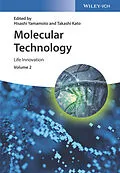Edited by foremost leaders in chemical research together with a number of distinguished international authors, Volume 2 presents the most important and promising recent chemical developments in life sciences, neatly summarized in one book.
Interdisciplinary and application-oriented, this ready reference focuses on methods and processes with a high practical aspect, covering new trends in drug delivery, in-vivo analysis, structure formation and much more.
Of great interest to chemists and life scientists in academia and industry.
Autorentext
Hisashi Yamamoto is Professor at the University of Chicago. He received his Ph.D. from Harvard under the mentorship of Professor E. J. Corey. His first academic position was as Assistant Professor and lecturer at Kyoto University, and in 1977 he was appointed Associate Professor of Chemistry at the University of Hawaii. In 1980 he moved to Nagoya University where he became Professor in 1983. In 2002, he moved to United States as Professor at the University of Chicago. He has been honored to receive the Prelog Medal in 1993, the Chemical Society of Japan Award in 1995, the National Prize of Purple Medal (Japan) in 2002, Yamada Prize in 2004, and Tetrahedron Prize in 2006 and the ACS Award for Creative Work in Synthetic Organic Chemistry to name a few. He authored more than 500 papers, 130 reviews and books (h-index ~90).
Takashi Kato is a Professor at the Department of Chemistry and Biotechnology at the University of Tokyo since 2000. After his postdoctoral research at Cornell University, Department of Chemistry with Professor Jean M. J. Frechet, he joined the University of Tokyo. He is the recipient of The Chemical Society of Japan Award for Young Chemists (1993), The Wiley Polymer Science Award (Chemistry), the 17th IBM Japan Science Award (Chemistry), the 1st JSPS (Japan Society for the Promotion of Science) Prize and the Award of Japanese Liquid Crystal Society (2008). He is the editor in chief of the "Polymer Journal", and member of the editorial board of "New Journal of Chemistry".
Inhalt
Foreword by Dr Hamaguchi xiii
Foreword by Dr Noyori xv
Preface xvii
1 Control of DNA Packaging by Block Catiomers for Systemic Gene Delivery System 1
Kensuke Osada
1.1 Introduction 1
1.2 Packaging of pDNA by Block Catiomers 2
1.2.1 Rod-Shaped Packaging of pDNA 3
1.2.2 Rod Shape or Globular Shape 5
1.3 PolyplexMicelles as a Systemic Gene Delivery System 6
1.3.1 Stable Encapsulation of pDNAWithin Polyplex Micelles for Systemic Delivery 6
1.3.2 PolyplexMicelles for Efficient Cellular Entry 9
1.3.3 PolyplexMicelles for Safe Endosome Escape 11
1.3.4 PolyplexMicelles for Nuclear Translocation 13
1.3.5 PolyplexMicelles for Efficient Transcription 13
1.4 Design Criteria of Block Catiomers Toward Systemic Gene Therapy 14
1.5 Rod Shape or Toroid Shape 17
1.6 Summary 18
References 18
2 Manipulation of Molecular Architecture with DNA 25
Akinori Kuzuya
2.1 Introduction 25
2.2 Molecular Structure of DNA 25
2.3 Immobile DNA Junctions 26
2.4 Topologically Unique DNA Molecules 28
2.5 DNA Tiles and Their Assemblies 28
2.6 DNA Origami 30
2.7 DNA Origami as a Molecular Peg Board 32
2.8 Molecular Machines Made of DNA Origami 33
2.9 DNA Origami Pinching Devices 33
2.10 Novel Design Principles 35
2.11 DNA-PAINT: An Application of DNA Devices 36
2.12 Prospects 36
References 36
3 Chemical Assembly Lines for Skeletally Diverse Indole Alkaloids 43
Hiroki Oguri
3.1 Introduction 43
3.2 Macmillan's Collective Total Synthesis by Means of Organocascade Catalysis 45
3.3 Systematic Synthesis of Indole Alkaloids Employing Cyclopentene Intermediates by the Zhu Group 52
3.4 Biogenetically Inspired Synthesis Employing a Multipotent Intermediate by the Oguri Group 58
References 68
4 Molecular Technology for Injured Brain Regeneration 71
Itsuki Ajioka
4.1 Introduction 71
4.2 Biology of Angiogenesis 71
4.3 Angiogenesis for Injured Brain Regeneration 73
4.4 Molecular Technology to Promote Angiogenesis 74
4.5 Biology of Cell Cycle 75
4.6 Biology of Neurogenesis 77
4.7 Molecular Technology to Promote Neuron Regeneration 78
4.8 Conclusion 80
References 80
5 Engineering the Ribosomal Translation Systemto Introduce Non-proteinogenic Amino Acids into Peptides 87
Takayuki Katoh
5.1 Introduction 87
5.2 Decoding the Genetic Code 88
5.3 Aminoacylation of tRNA by Aminoacyl-tRNA Synthetases 90
5.4 Methods for Preparing Noncanonical Aminoacyl-tRNAs 91
5.4.1 Ligation of Aminoacyl-pdCpA Dinucleotide with tRNA Lacking the 3-Terminal CA 91
5.4.2 Post-aminoacylationModification of Aminoacyl-tRNA 93
5.4.3 Misacylation of Non-proteinogenic Amino Acids by ARSs 94
5.4.4 Flexizyme, an Aminoacylation Ribozyme 94
5.5 Methods for Assigning Non-proteinogenic Amino Acids to the Genetic Code 95
5.5.1 The Nonsense Codon Method 96
5.5.2 Genetic Code Reprogramming 97
5.5.3 The Four-base Codon Method 98
5.5.4 The Nonstandard Base Method 100
5.6 Limitation of the Incorporation of Noncanonical Amino Acids: Substrate Scope 101
5.7 Improvement of the Substrate Tolerance of Ribosomal Translation 103
5.8 Ribosomally Synthesized Noncanonical Peptides as Drug Discovery Platforms 104
5.9 Summary and Outlook 105
References 106
6 Development of Functional Nanoparticles and Their Systems Capable of Accumulating to Tumors 113
Satoru Karasawa
6.1 Introduction 113
6.2 Accumulation Based on Aberrant Morphology and Size 114
6.3 Accumulation Based on Aberr...
